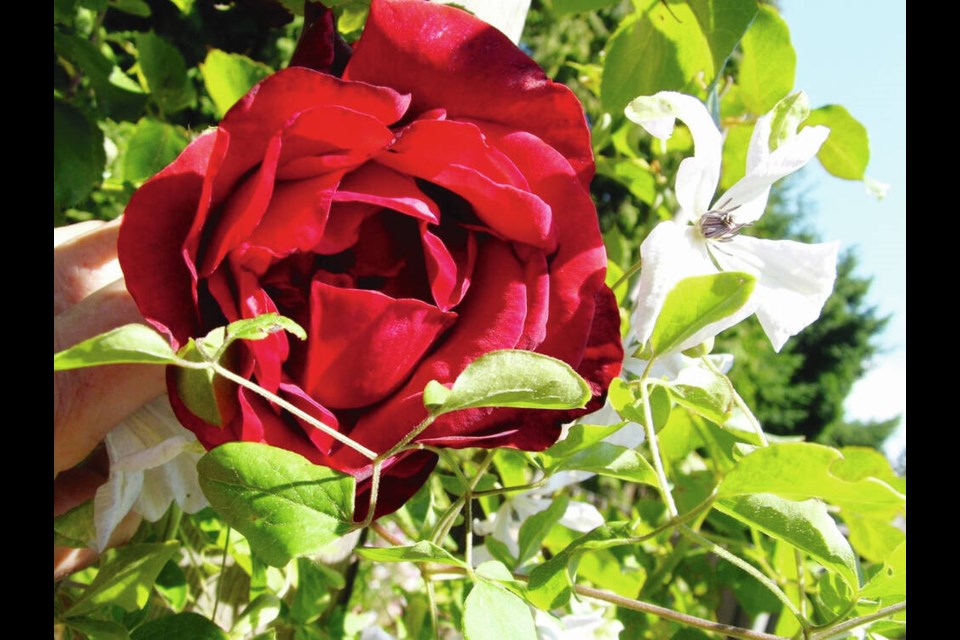Dear Helen: You have mentioned growing climbing roses with clematis vines. How did you come to create these pairings, and what varieties did you plant together?
V.W.
I made these plantings a few decades ago, when a mail order source for miniature roses was still in existence and small-flowered clematis vines were more readily available. Many local garden centres order their clematis vines from Clearview Horticultural in Aldergrove. It’s always worth asking your favourite nursery to order particular plants for you.
A colour gallery of clematis varieties and other vines, and information on clematis care, can be found at . Some are available, both in the retail and online (mail order) stores from Wildwood Outdoor Living Centre on Elk Lake Drive. Elk Lake Garden Centre is another source.
I have three clematis-rose pairings in the garden, at corners of vegetable plots. One of the roses is not a miniature, but a large-flowered climber that, unlike most large-flowered climbing roses, will bloom well when grown in straight-up “pillar” form. The flowers are dark red, double, and intensely fragrant.
Don Juan grows against a stout post together with Alba Luxurians, a mall-flowered, summer-blooming Clematis viticella variety with green-tipped white blossoms.
A Laura Ford climbing miniature rose blooms with another Clematis viticella called Abundance. Laura Ford bears double yellow flowers tinged lightly with shrimp.
The stellar Clematis viticella Mme Julia Correvon blooms in dark wine red with Warm Welcome, a miniature climbing rose with vivid orange flowers.
These vines are easily cared for. In late winter I trim the roses back lightly and cut the clematis stems down close to the ground. New stems will carry the summer flowers.
Dear Helen: Your mention, and photo, of California tree poppies reminded me that I have promised to share a plant with a neighbour who has wanted one for a long time. I’ve heard they are very difficult to transplant successfully. I’d appreciate any tips you might have on the timing and best procedure.
F.N.
California tree poppies (Matilija poppy, Romneya coulteri) are notoriously difficult to transplant. It took me several tries before I succeeded in getting a plant established in the garden.
Once a Romneya coulteri is well settled in, it will begin to spread on underground runners. Every spring I find new plants sprouting in the most unlikely locations. A reader of this column once wrote to tell me about a runner from one of her plants, growing near a garage wall, producing a fresh shoot on the far side of the garage. That’s quite a journey for a plant runner.
In early spring, I would begin watching for new sprouts produced by a runner — not one of the established plants, but a fresh sprout. Prepare a one-gallon pot with a plump-textured but free-draining soil. Carefully dig the Romneya sprout along with a portion of runner that will fit easily into the pot.
If you can find them, pot several new sprouts in separate pots. Place them in a warm, sheltered spot and keep the soil just modestly moist. You will know, with new growth, whether the small plants have survived. When they seem robust enough but remain young and actively growing, pass them to your neighbour for planting.
Dear Helen: Is this a suitable time to prune some of my overgrown summer-flowering shrubs?
R.A.
I would caution against it, in view of the challenging weather conditions of last fall and winter, which were unusually warm and dry until around mid-January, when temperatures fell suddenly to record lows.
Because the winter had been so unusually warm, buds on some plants had begun to swell. Soils were dry. These conditions rendered many plants vulnerable to damage in severe cold temperatures and some were lost.
The best safeguards we can provide hardy and marginally hardy plants against weather extremes is to send them into winter as well hardened against cold as possible by not fertilizing beyond midsummer and not pruning after mid-August. Late summer fertilizing and pruning stimulate new growth that does not have time to harden against adverse weather.
GARDEN EVENT
Plant propagation. Dinter Nursery, 2205 Phipps Rd. in Duncan, is presenting a Plant Propagation and Division seminar on Saturday, August 24, from 10 to 11 a.m. Cost is $10 + GST. Registration in advance, with payment, is required as space is limited. Book a place with credit card over the phone or in person at the nursery. 250-748-2023. .



